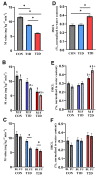Intramyocellular Triglyceride Content During the Early Course of Type 1 and Type 2 Diabetes
- PMID: 37478166
- PMCID: PMC10545555
- DOI: 10.2337/db23-0353
Intramyocellular Triglyceride Content During the Early Course of Type 1 and Type 2 Diabetes
Abstract
Intramyocellular lipid content (IMCL) is elevated in insulin-resistant humans, but it changes over time, and relationships with comorbidities remain unclear. We examined IMCL during the initial course of diabetes and its associations with complications. Participants of the German Diabetes Study (GDS) with recent-onset type 1 (n = 132) or type 2 diabetes (n = 139) and glucose-tolerant control subjects (n = 128) underwent 1H-MRS to measure IMCL and muscle volume, whole-body insulin sensitivity (hyperinsulinemic-euglycemic clamps; M-value), and cycling spiroergometry (VO2max). Subgroups underwent the same measurements after 5 years. At baseline, IMCL was ∼30% higher in type 2 diabetes than in other groups independently of age, sex, BMI, and muscle volume. In type 2 diabetes, the M-value was ∼36% and ∼62% lower compared with type 1 diabetes and control subjects, respectively. After 5 years, the M-value decreased by ∼29% in type 1 and ∼13% in type 2 diabetes, whereas IMCL remained unchanged. The correlation between IMCL and M-value in type 2 diabetes at baseline was modulated by VO2max. IMCL also associated with microalbuminuria, the Framingham risk score for cardiovascular disease, and cardiac autonomic neuropathy. Changes in IMCL within 5 years after diagnosis do not mirror the progression of insulin resistance in type 2 diabetes but associate with early diabetes-related complications.
Article highlights: Intramyocellular lipid content (IMCL) can be elevated in insulin-resistant humans, but its dynamics and association with comorbidities remain unclear. Independently of age, sex, body mass, and skeletal muscle volume, IMCL is higher in recent-onset type 2, but not type 1 diabetes, and remains unchanged within 5 years, despite worsening insulin resistance. A degree of physical fitness modulates the association between IMCL and insulin sensitivity in type 2 diabetes. Whereas higher IMCL associates with lower insulin sensitivity in people with lower physical fitness, there is no association between IMCL and insulin sensitivity in those with higher degree of physical fitness. IMCL associates with progression of microalbuminuria, cardiovascular disease risk, and cardiac autonomic neuropathy.
© 2023 by the American Diabetes Association.
Conflict of interest statement
Figures


References
-
- Krssak M, Falk Petersen K, Dresner A, et al. . Intramyocellular lipid concentrations are correlated with insulin sensitivity in humans: a 1H NMR spectroscopy study. Diabetologia 1999;42:113–116 - PubMed
-
- Perseghin G, Scifo P, De Cobelli F, et al. . Intramyocellular triglyceride content is a determinant of in vivo insulin resistance in humans: a 1H-13C nuclear magnetic resonance spectroscopy assessment in offspring of type 2 diabetic parents. Diabetes 1999;48:1600–1606 - PubMed
-
- Jacob S, Machann J, Rett K, et al. . Association of increased intramyocellular lipid content with insulin resistance in lean nondiabetic offspring of type 2 diabetic subjects. Diabetes 1999;48:1113–1119 - PubMed
-
- Perseghin G, Lattuada G, Danna M, et al. . Insulin resistance, intramyocellular lipid content, and plasma adiponectin in patients with type 1 diabetes. Am J Physiol Endocrinol Metab 2003;285:E1174–E1181 - PubMed
Publication types
MeSH terms
Substances
LinkOut - more resources
Full Text Sources
Medical

